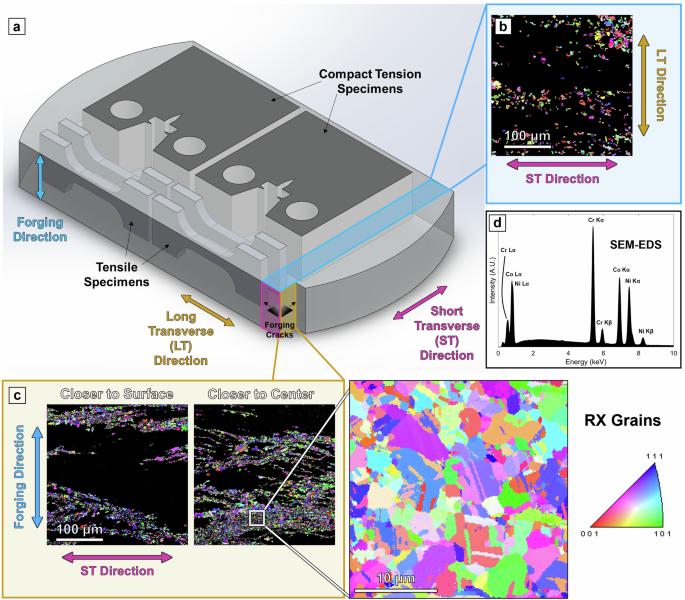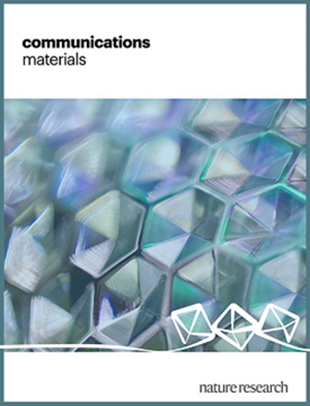部分再结晶组织扩大了CrCoNi中熵合金的强度-韧性包络层
IF 9.6
Q1 MATERIALS SCIENCE, MULTIDISCIPLINARY
引用次数: 0
摘要
工程材料在强度和抗裂纹扩展(断裂韧性)之间表现出一种不理想的权衡。在这里,我们展示了如何通过产生部分再结晶的非均匀微观结构的热机械加工来规避这种权衡。在室温(298 K)下锻造了一种等摩尔CrCoNi合金,产生了高密度的三维晶体缺陷网络。变形后热处理引起局部再结晶,形成坚硬的非再结晶晶粒和柔软的再结晶晶粒的双峰组织。在此条件下,合金在298 K时的屈服强度是完全再结晶状态下的2.75倍,而断裂韧性保持不变。在不影响断裂韧性的情况下,屈服强度在77 K时进一步提高。在77 K时,这种突出的强度-韧性组合超过了其他金属材料,这似乎是由微观结构的复合性质造成的,非再结晶晶粒提供强度,再结晶晶粒提供塑性,在裂纹扩展过程中消散应力。我们的研究结果表明,通过热机械加工技术调整再结晶程度,将有可能进一步扩大工程部件尺度上一系列结构金属的强度和韧性的包络范围。对工程合金的研究往往是由同时提高强度和韧性的需要驱动的。在这里,等摩尔CrCoNi中熵合金在不牺牲韧性的情况下获得了几乎三倍的屈服强度提高,这归因于部分再结晶组织。本文章由计算机程序翻译,如有差异,请以英文原文为准。

Partially recrystallized microstructures expand the strength-toughness envelope of CrCoNi medium-entropy alloy
Engineering materials exhibit an undesirable tradeoff between strength and resistance to crack propagation (fracture toughness). Here we demonstrate how this tradeoff can be circumvented by thermo-mechanical processing that produces a partially recrystallized, heterogeneous microstructure. An equimolar CrCoNi alloy was forged at room temperature (298 K) to produce high densities of three-dimensional crystallographic defect networks. Post-deformation heat treatments caused localized recrystallization that resulted in a bimodal microstructure with hard, non-recrystallized grains and soft, recrystallized grains. In this condition, the yield strength at 298 K is 2.75x the values previously obtained for the same alloy in the fully recrystallized state while the fracture toughness remains the same. The yield strength is further enhanced at 77 K without compromising the fracture toughness. This outstanding strength-toughness combination at 77 K exceeds those reported for other metallic materials and appears to result from the composite nature of the microstructure with non-recrystallized grains providing strength and recrystallized grains enabling plasticity that dissipates stresses during crack propagation. Our findings indicate that by tuning the degree of recrystallization through thermomechanical processing techniques, it will be possible to further expand the envelope bounding the strength and toughness of a range of structural metals at engineering component scales. Research into engineering alloys is often driven by the need to simultaneously improve strength and toughness. Here, an equimolar CrCoNi medium-entropy alloy achieves an almost three times increase in yield strength without sacrificing toughness, attributed to a partially recrystallized microstructure.
求助全文
通过发布文献求助,成功后即可免费获取论文全文。
去求助
来源期刊

Communications Materials
MATERIALS SCIENCE, MULTIDISCIPLINARY-
CiteScore
12.10
自引率
1.30%
发文量
85
审稿时长
17 weeks
期刊介绍:
Communications Materials, a selective open access journal within Nature Portfolio, is dedicated to publishing top-tier research, reviews, and commentary across all facets of materials science. The journal showcases significant advancements in specialized research areas, encompassing both fundamental and applied studies. Serving as an open access option for materials sciences, Communications Materials applies less stringent criteria for impact and significance compared to Nature-branded journals, including Nature Communications.
 求助内容:
求助内容: 应助结果提醒方式:
应助结果提醒方式:


